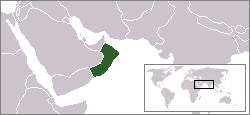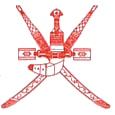Oman
Like a figurehead on a ship's prow, the shape of which it resembles, the Sultanate of Oman juts sharply from the southeast coast of the Arabian Peninsula into the Arabian Sea. The world's easternmost Arabian country, Oman shares desert borders with Saudi Arabia, the United Arab Emirates, and Yemen. The seacoast also includes the Gulf of Oman in the northeast, where the exclave peninsula of Musandam looks across the Strait of Hormuz to Iran.
| |||||
| National motto: none | |||||

| |||||
| Official language | Arabic | ||||
| Capital | Muscat | ||||
| Sultan | Qaboos bin Said Al Said | ||||
| Area - Total - % water |
Ranked 83rd 309,500 km² 0% | ||||
| Population - Total (2005) - Density |
Ranked 132nd 3,001,583 12.3/km² | ||||
| Independence | 1650 (expulsion of the Portuguese); 1971 from the UK | ||||
| National anthem | Nashid as-Salaam as-Sultani | ||||
| Currency | Rial | ||||
| Time zone | UTC+4 | ||||
| Internet TLD | .om | ||||
| Calling Code | 968 | ||||
Geography
Most of Oman (about 80%) is covered by a broad, rocky, barren, and mainly flat desert, the Rub al-Khali, the same vast expanse that dominates southern Saudi Arabia. Though Omani culture and customs have their origins in the tribal life that developed in this region, in the modern era only the occasional wadi, oasis, and camel are found there.
The Hajar Mountains in the northeast run parallel to the coast, with one peak reaching nearly 3,000 meters. They afford the country's only moderate temperatures in the summer from the intense heat that afflicts most of the Arabian Peninsula.
Oman's capital, Muscat, and the other main towns are all located along the narrow coastal plain. The climate on this strip of land differs from that of the interior desert only in levels of humidity. The coast in the unpopulated southwest is characterized by its towering cliffs.
The Musandam exclave (similar to Alaska's geographical relationship to the contiguous United States) commands a strategic site overlooking the choke point between the Gulf of Oman and the Persian Gulf (known by Arabs as the Arabian Gulf). It's a land apart from the Omani mainland in another sense, that being its terrain and economy. Its main prong thrusting into the Strait of Hormuz is jagged and flooded and has been compared to Norway and its fjords.
There is an additional exclave, though a smaller one, between Musandam and the rest of Oman, in the territory of the United Arab Emirates (UAE), which makes it an enclave as well as an exclave. And inside the Omani enclave is a tiny enclave of the UAE, the world's only such geographical oddity.
Omanis number about three million. In both population and size, the country is similar to Kansas.
History
In ancient history, the region of Oman was known principally for its copper mining, an activity still pursued in the present. Over the centuries the area was ruled intermittently by its transgulf neighbors, the Persians. Arab tribes moved into Oman, probably from Yemen, and had taken control of the area by the 7th century C.E. (The name Oman possibly derives from the name of a Yemeni tribe of that era.)
The people of the region converted to Islam within the prophet Muhammad's lifetime. By the middle of the 8th century, they were practicing a unique brand of the faith, Ibadhism, which remains the majority sect only in Oman. Ibadhism has been characterized as "moderate conservatism," with tenets that are a mixture of both austerity and tolerance.
The Portuguese occupied Muscat for a 140-year period (1508-1648), arriving a decade after Vasco da Gama discovered the seaway to India. In need of an outpost to protect their sea-lanes, the Europeans built up and fortified the city, where remnants of their colonial architectural style still remain.
The Ottomans drove out the Portuguese, but were pushed out themselves about a century later (1741) by the leader of a Yemeni tribe, who began the current line of ruling sultans. After one last, brief invasion a few years later by Persia, Oman was free for good of foreign occupying powers.
Isolated from their Arab neighbors by the desert, the Omanis became an economic power in the early 1800s, largely by using their position on the Indian Ocean and seafaring knowledge gained from the Portuguese to gain access to foreign lands. They took control of the coasts of presentday Iran and Pakistan, colonized Zanzibar and Kenyan seaports, and sent boats trading as far afield as the Malay Peninsula.
At this time, the country became known as Muscat and Oman, denoting two centers of power, not just the capital and the interior but also the sultan and the imam, the Ibadhist spiritual leader.
The British slowly brought about a collapse of Muscat and Oman's "empire" by the end of the 19th century without use of force. Through gradual encroachment on its overseas holdings economically and politically, they caused Oman to retreat to its homeland. In time Britain held such sway in Muscat and Oman itself that it became in effect, and later in fact, a British protectorate.
Having control of the country's military, the British helped subdue rebel tribesmen in the 1950s, driving most into Yemen. But the sultan's was a repressive regime, with laws forbidding numerous activities, including the building and even repair of people's own homes without permission. In 1970, almost certainly with British backing, he was overthrown by his son, the present ruler, Qaboos bin Said Al Said, and the country declared independence the following year as the Sultanate of Oman.
Qaboos is generally regarded as a benevolent absolute ruler, who has improved the country economically and socially. Oman has maintained peaceful ties on the Arabian Peninsula ever since ending another tribal rebellion in the southwest in 1982 by forging a treaty with Yemen.
Except for those who travel to remote Mideast locales for striking vistas of coastal beauty, the country has seldom been in the public eye other than for the use of its military bases by U.S. forces in recent years. American and British bombing raids were launched in 1991 from Oman against Iraq in the Gulf War. A decade later U.S. forces stationed there were involved in raids against Afghanistan and Osama bin Laden.
Economy
Though Oman is not a major world petroleum producer, crude oil dominates the country's economy and commands 90% of its exports. The initial oil discoveries were made in the early 1960s by European companies, but since 1974 the Omani government has held 60% of the national oil company, the sole producer. The country has never been a member of OPEC.
There are also sizable reserves of natural gas. In the agricultural sector, there is subsistence farming in the coastal areas, as well as larger-scale cultivation of vegetables and fruit, such as dates and limes. The top export after petroleum is fish, most of which is sold to Oman's peninsular neighbors. Much of it is caught off Musandam, a place also appealing to undersea diving enthusiasts from overseas.
Centuries ago the area of Oman and Yemen was known for its production of frankincense, a tree resin that was used in religious ceremonies and was extremely costly. Modern cultivation and harvesting of the resin still exists.
Demographics
Even though the majority of Omanis are Arabs, there is a sizable native minority of Indian, Iranian, and Pakistani ancestry, as well as a small community of African descent. Some portions of these communities date back to the 19th century when Oman was a colonizing power. As in most other Arab countries, a large number of foreign laborers live here, mostly from India, Pakistan and Iran. The official language is Arabic, but the minorities speak their own languages. A non-Arabic Semitic language is spoken in Dhofar.
Islam is the predominant religion, mostly Ibadhi Muslims with a Sunni population in Dhofar.
Culture
Oman's oil revenue has been consistently invested in the national infrastructure, particularly roads, schools, hospitals, and utilities. Along with its strategic trade location on the Indian Ocean and the Persian Gulf, Oman's choice of outlays may poise it for continued economic growth.
Although Oman is a modern country, western influences are quite restricted; the Ibadhi form of Islam is very strict in comparison with Sunni Islam and Shi'a Islam.
Although Arabic is Oman's official language, there are still native speakers of dialects or offshoots of Southern Arabian, a Semitic language only distantly related to Arabic. However, even in Oman the dominant indigenous language is a dialect of Arabic.
Although the sultan functions basically as an absolute Ruler, he has the approval of most of the Omanis: in his 30 years of government he has greatly improved the situation in the country. The governmental system is very gradually developing in the direction of some democracy.
Credits
New World Encyclopedia writers and editors rewrote and completed the Wikipedia article in accordance with New World Encyclopedia standards. This article abides by terms of the Creative Commons CC-by-sa 3.0 License (CC-by-sa), which may be used and disseminated with proper attribution. Credit is due under the terms of this license that can reference both the New World Encyclopedia contributors and the selfless volunteer contributors of the Wikimedia Foundation. To cite this article click here for a list of acceptable citing formats.The history of earlier contributions by wikipedians is accessible to researchers here:
The history of this article since it was imported to New World Encyclopedia:
Note: Some restrictions may apply to use of individual images which are separately licensed.
